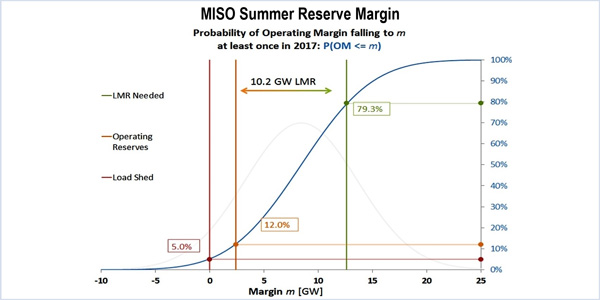By Amanda Durish Cook
MISO’s summer planning reserve margins will remain firmly above requirements even after it shaved nearly half a percentage point from an initial assessment for the season.
The grid operator now predicts an 18.8% reserve margin, down 0.4% from a March estimate — made before the Planning Reserve Auction — and 0.6% above last summer’s reserve. (See Anemic Loads, Plentiful DR Boost MISO Summer Outlook.)
Reserve margins could range anywhere from 14.1 to 19.7% throughout the summer, and MISO sees a high probability (79.3%) for calling up load-modifying resources and a much lower one (12%) for exhausting its 10.2 GW of LMRs and dipping into operating reserves. The chance of load shedding stands at 5%.
Based on forecasts for above-normal temperatures in its footprint this summer, the RTO expects peak demand to hit 125.1 GW, with 148.5 GW of available capacity on hand to meet it. Summer demand peaked at 120.7 GW last year.
“We are expecting to have sufficient resources in the footprint,” Todd Ramey, MISO vice president of system operations, said during an annual summer readiness workshop on May 8.
While forecasts for declining demand are driving up the base reserve margin, the increased Midwest-South regional transfer limit is providing extra wiggle room, the RTO said.
“We appreciate the ongoing efforts of load-serving entities and states to ensure adequate resources are in place,” Ramey said in a press release.
The forecasted above-normal summer temperatures “can pose some operational challenges,” said Darius Monson, MISO resource adequacy adviser. “It’s worth noting, in a high-load scenario, we are planning to rely heavily on demand response resources.”
The summer reserve estimates include total firm imports, DR and energy efficiency resources based on cleared megawatts in the 2017/18 capacity auction. Non-firm deliveries were excluded from the summer assessment.
“In reality, there might be additional non-firm support,” Monson said.
The RTO also assumed that planned and forced outages would be consistent with the previous five years, and that no MISO South capacity would be stranded in a post-outage situation.
MISO will also hold realistic hurricane simulations with MISO South operators May 23-24 and June 20-21, a first for the RTO, which ordinarily holds less-detailed hurricane drills, according to Marty Sas, senior manager of South reliability coordination. The exercise will start with an intact system and simulate a 31-hour storm that takes nearly 200 transmission lines and 25 generators out of service.




